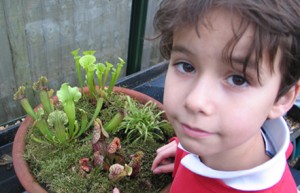A few years back, there was an ad on TV for some sort of ready meal. In the 10 minutes it took to ‘boil in the bag’, the woman was able to use the extra time to take up the cello, get as fit as Madonna or complete her Phd.
I thought about this the other day when I dashed into the greenhouse in the evening while the children were out at Brownies and Beavers. On went the light and the radio and for a delicious half-hour I sieved some compost and planted up some hardy winter lettuce . Monday night is guitar-lesson night, so back I went to sieve more compost and start off some broad beans . Another night, the three of them piled into the greenhouse while the dinner cooked, to sow some mixed cacti seed we’d bought at Kew Gardens. (Yes, we are now into competitive cacti growing.)
All this leads me to conclude that my single biggest tip if you are getting a new greenhouse is: get your greenhouse wired up for lighting (and heating).
Although the nights are getting lighter, if you go out to work or have other things to do during the day, it makes such a difference to be able to garden exactly when you want to and use spare bits of time productively. That’s without mentioning the possibilities that greenhouses afford as a bolt-hole from domestic life.I never used to sieve my compost for seedlings, but now that I have a greenhouse I must admit that I do feel a bit more grown-up as a gardener.
Broad beans normally do well just being plonked in the ground, but my allotment site is so windy and exposed that starting them off beforehand gives them the extra push they need to put on good growth. With an eye to saving on heating costs, I have set up my old, cheap plastic mini-greenhouse inside the glass one in order to have a ‘greenhouse within a greenhouse’ for seedlings which have already germinated and don’t need to be in the propagator or on a heated mat. I open the polythene sheeting on this plastic greenhouse first thing in the morning then close it again in the evening when the temperature drops. Not only does this help to establish a micro-climate, it also gets you into a good routine of visiting the greenhouse every day to keep on eye on things. So, I suppose my Golden rule No.2 would be: Get into the habit of going to the greenhouse when you get up in the morning and then again in the early evening.

HOW TO SOW CACTI SEED
Cacti seed are not too difficult to germinate (whatever you read in books!). They can be sown all year round in the greenhouse and have the advantage of giving you something interesting to look at every time you pay a visit.
Some of the seeds are minute – put them on a white piece of paper to see what you are doing, then try to pick up and dot each one about a centimetre from the other on the compost. You can buy special cacti compost, or John Innes seed compost, which is sandy and free draining and works just as well. Cacti seeds germinate at different rates, so it’s best to leave them all till they are about the size of two match-heads then pot them on in a small container. (Given that you may have around 40 plants from a packet, square pots fit neatly onto a tray and save space).
I am reading An Orchard Invisible, A Natural History of Seeds by Jonathan Silvertown (University of Chicago Press, to be Published in April 2009.) Prof. Silvertown is Professor of Ecology at the Open University. If only more academics wrote like him – his style is lively and engaging rather than dry and impenetrable. The book covers numbers of seeds, poisons, edible seeds, why some have lots of oil and others starch. He also explains why the seed of a giant redwood (Sequoiadendron giganteum), a tree which can weigh as much as six jumbo jets, weighs only a six thousandth of a gram.
I quote here from the uncorrected proof: evolution cooked up something brand-new to serve the demands of life on land: an embryo in a box which we will call a seed. In fact the box contains not just an embryo, but a food store placed there by mother, so a seed is really an embryo in a picnic basket.


